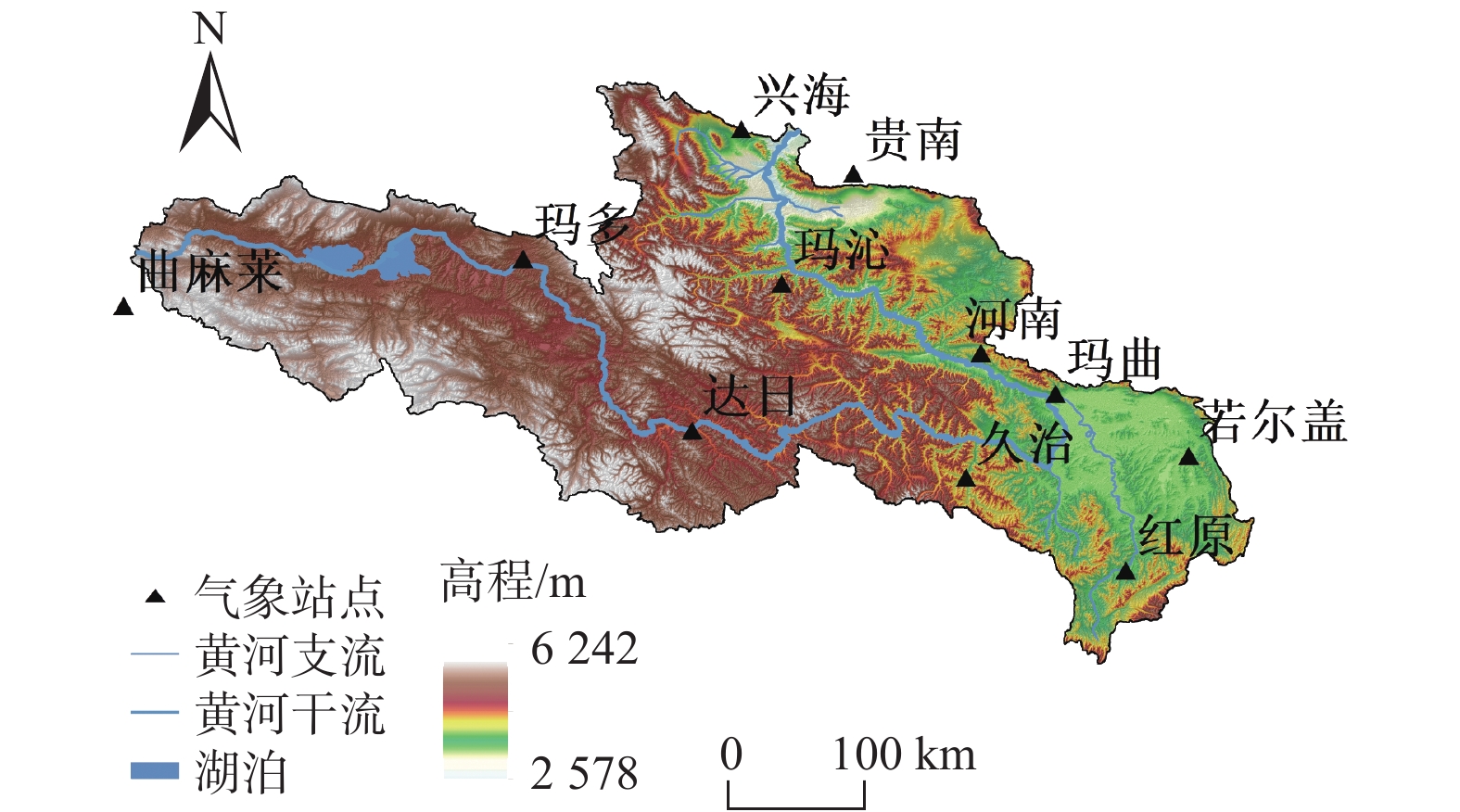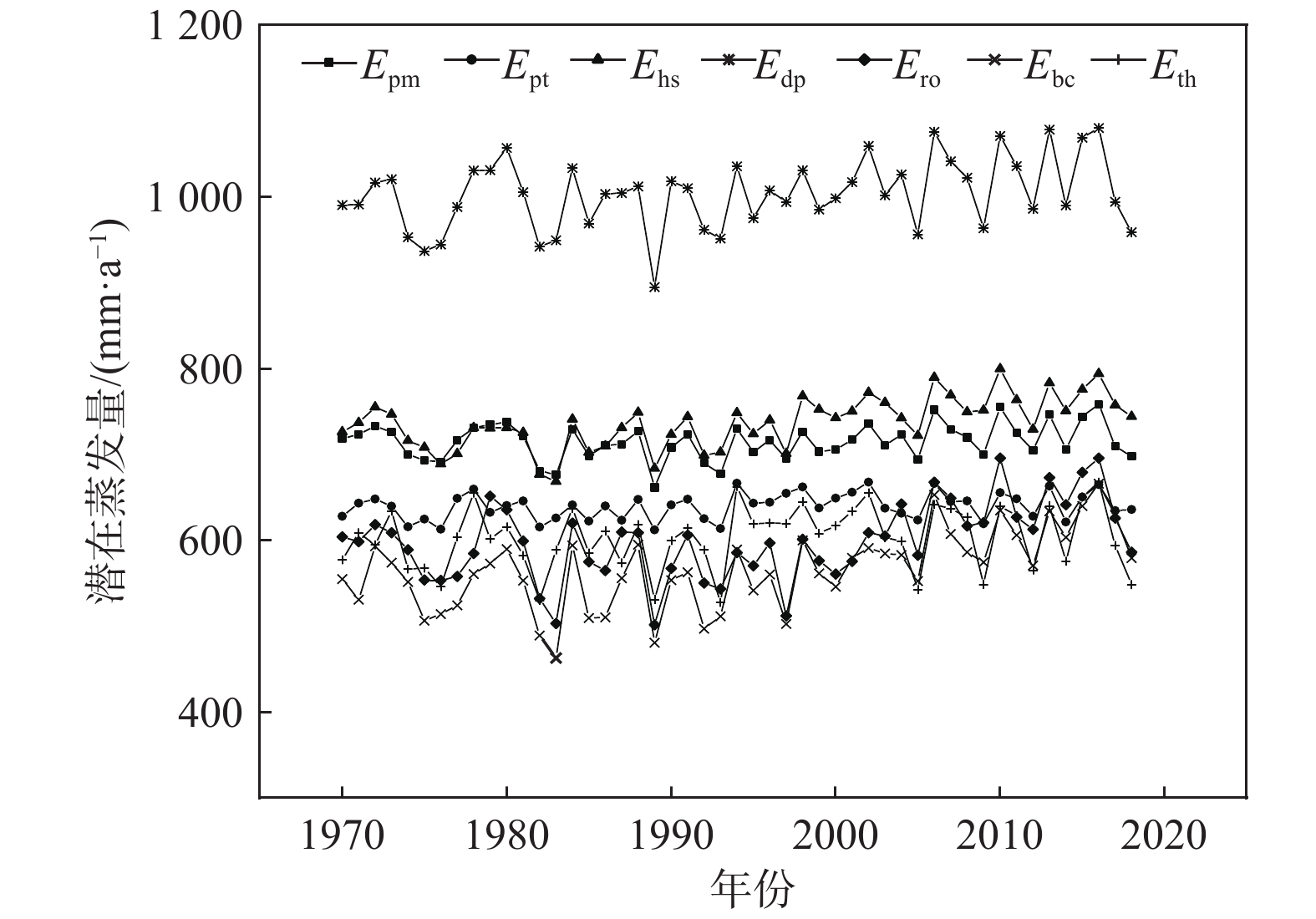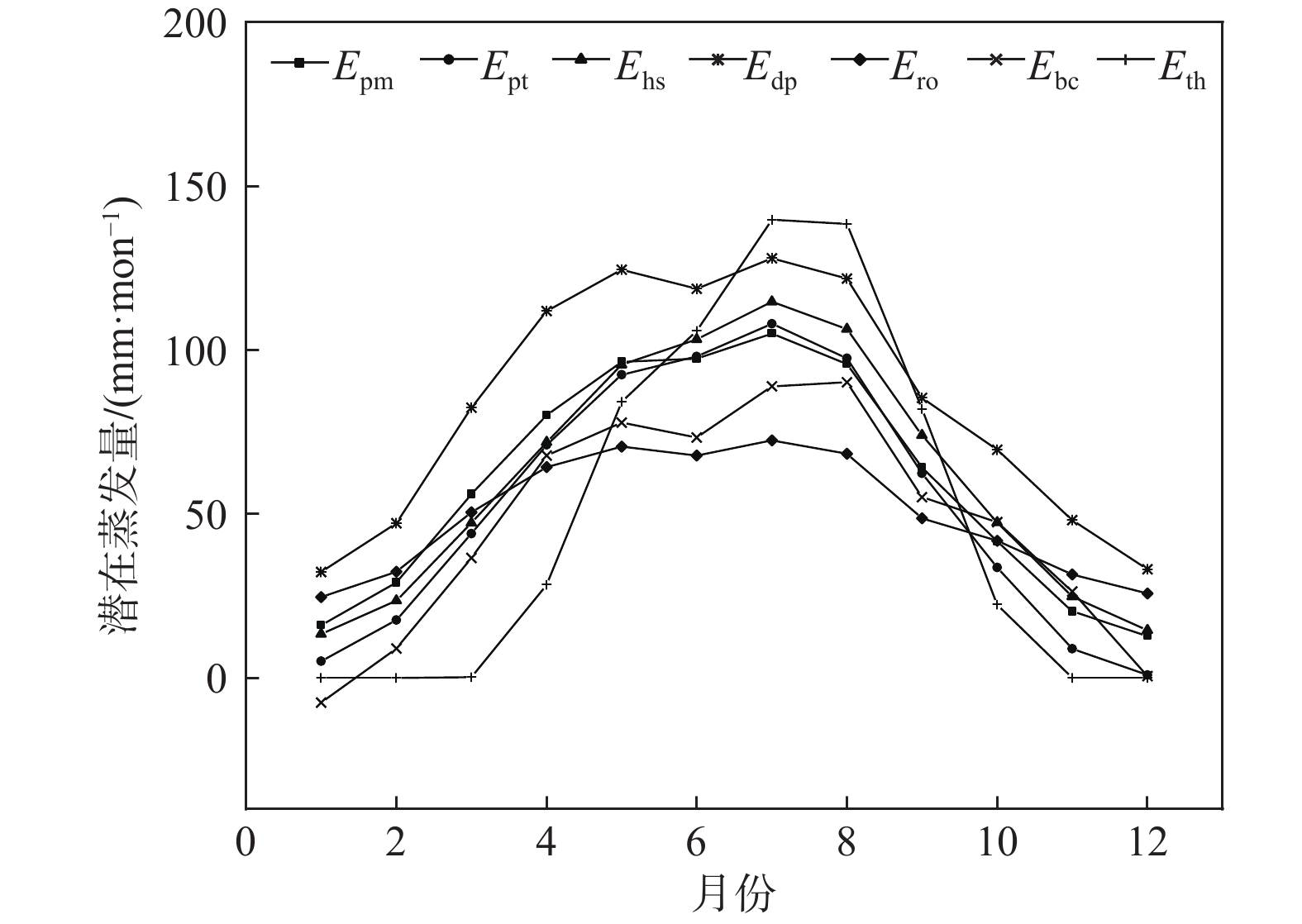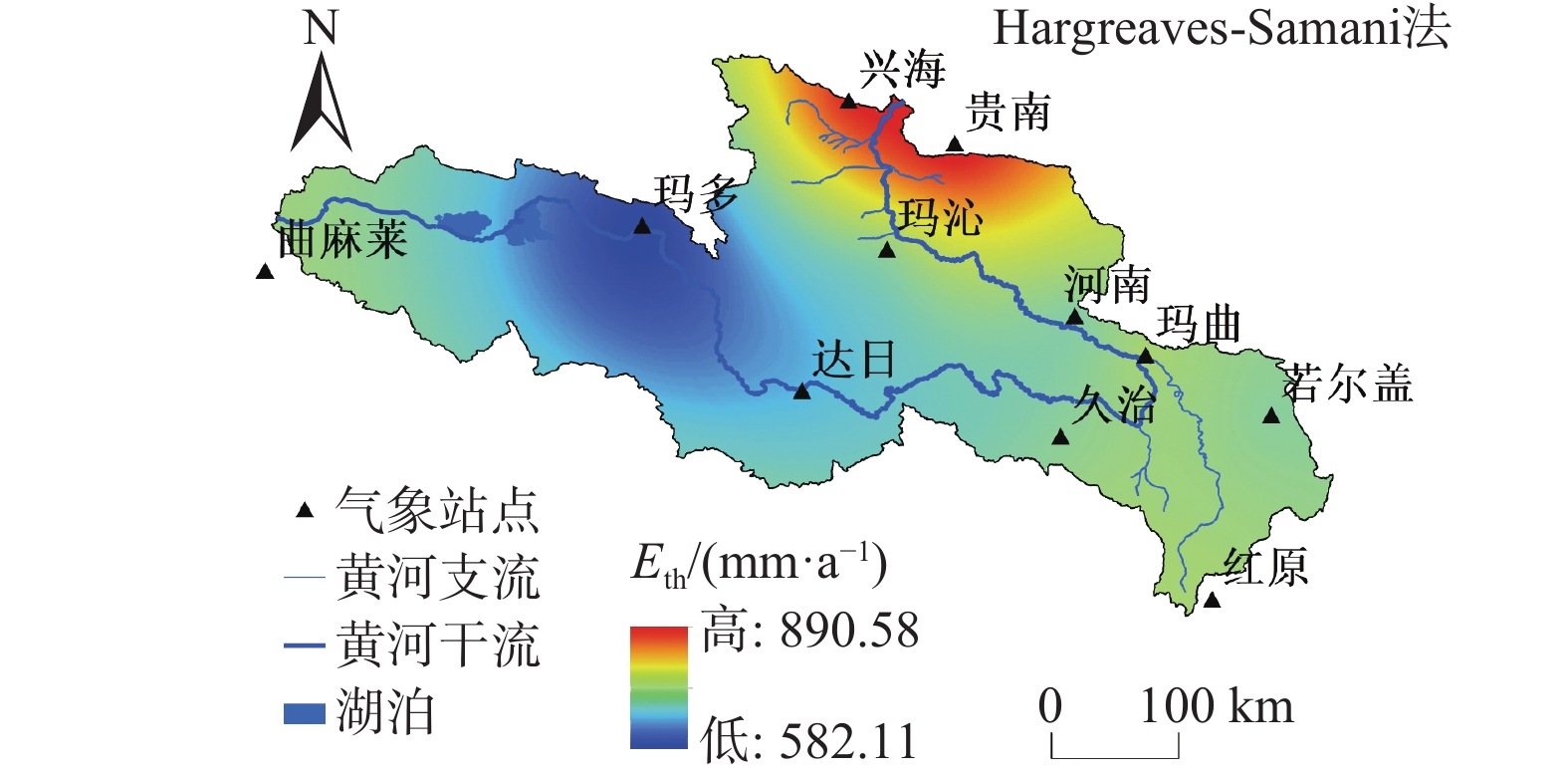The applicability of various potential evapotranspiration estimation methods in the headwater area of the Yellow River
-
摘要:
潜在蒸散量(Potential Evapotranspiration)是区域水量平衡研究的重要参数。为在资料短缺的情况下准确计算潜在蒸散量,并科学评价其简化算法的适用性。基于黄河源区11个气象站点1970—2018年气温、降水、相对湿度、风速、日照时数等逐日观测资料,以联合国粮农组织(FAO)推荐的Penman-Monteith(PM)法为参考,从年、月及空间尺度等方面分析了Priestly-Taylor(PT)法、Doorenbos-Pruitt(DP)法、Hargreaves-Samani(HS)法、Rohwer(RO)法、Thornthwaite(TH)法、Blaney-Criddle(BC)法6种简易算法的计算精度。结果表明在黄河源区HS法与PM法的平均偏差最低,仅为3.487 mm/mon,精度最高。但HS法未考虑平均相对湿度对于潜在蒸散量估算效果的影响,在气候湿润的黄河源区东南部红原县、河南县、若尔盖县、玛曲县及久治县存在精度不高的问题。因此引入平均相对湿度因子对HS法进行修正,并评价了改进后的HS法的应用效果。结果表明,引入平均相对湿度因子修正HS法后,黄河源区整体年潜在蒸散量的平均偏差由−22.008 mm/a降至6.174 mm/a;月潜在蒸散量的平均偏差由3.487 mm/mon降至1.031 mm/mon;空间尺度上,以上5县的平均偏差明显降低,平均降幅达5.33 mm/mon。表明改进后的HS法能够有效解决黄河源区东南部精度不高的问题,可以为黄河源区潜在蒸散量的简化计算提供参考。
-
关键词:
- 潜在蒸散量 /
- 适用性 /
- Hargreaves-Samani法修正 /
- 黄河源区 /
- 估算方法
Abstract:Potential evapotranspiration is an essential parameter for regional water balance analysis. To realize the accurate calculation of potential evapotranspiration when data are lacking, scientific evaluation of the applicability of the simplified potential evapotranspiration algorithm in the headwater area of the Yellow River is carried out. Based on daily observation data of temperature, precipitation, relative humidity, wind speed, and sunshine hours from 11 meteorological stations in the headwater area of the Yellow River from 1970 to 2018, the calculation accuracy of six simplified methods for potential evapotranspiration calculation are analyzed by using the FAO Penman-Monteith (PM) method as a reference method from the aspects of the year, month and spatial scales, including the Priestly-Taylor (PT) method, Doorenbos-Pruitt (DP) method, Hargreaves-Samani (HS) method, Rohwer (RO) method, Thornthwaite (TH) method and Blaney-Criddle (BC) method. The results show that the mean deviation between the HS method and the PM method, only 3.487 mm/mon, is the lowest in the headwater area of the Yellow River and the accuracy is the highest. However, the HS method does not consider the influence of the average relative humidity on potential evapotranspiration estimation, resulting in low accuracy in the humid climate of Hongyuan County, Henan County, Ruoergai County, Maqu County and Jiuzhi County in the southeast of the headwater area of the Yellow River. Therefore, this article introduces the average relative humidity factor to modify the HS method and evaluates the application effect of the improved HS method. It is found that after the HS method is revised, the mean deviation of the overall annual potential evapotranspiration in the headwater area of the Yellow River decreases from −22.008 mm/a to 6.174 mm/a, and the mean deviation of the monthly potential evapotranspiration decreases from 3.487 mm/mon to 1.031 mm/mon, respectively. On the spatial scale, the mean deviation of the above 5 counties decreases significantly, with an average drop of 5.33 mm/mon, indicating that the improved HS method can effectively solve the problem of low accuracy in the southeast of the headwater area of the Yellow River, and can provide a reference for the simplified calculation of potential evapotranspiration in the headwater area of the Yellow River.
-

-
表 1 潜在蒸发量估算公式
Table 1. Estimation formula of potential evapotranspiration
方法 公式 参数含义 优点 不足 PM法[15] 
 为温度对饱和水汽压曲线的斜率/(
为温度对饱和水汽压曲线的斜率/(
 );Rn和G分别为地表净辐射和日土壤热通量/(
);Rn和G分别为地表净辐射和日土壤热通量/(
 );
);
 为干湿表常数/(
为干湿表常数/(
 );T为日平均气温/
);T为日平均气温/
 ;U2为2 m处风速/(m·s−1);es和ea分别为饱和水汽压和实际水汽压/kPa
;U2为2 m处风速/(m·s−1);es和ea分别为饱和水汽压和实际水汽压/kPa
联合国粮农组织推荐的首选方法,物理意义强,综合考虑了辐射项和风速项 需要的气象资料及模型参数多,在资料短缺的地区应用受到限制 BC法[16] 
p为白天天数占全年白天天数的百分比;Ta为月平均气温/ 
所需资料和参数少,计算
简便计算精度较低 TH法[17] 
I为年温度效率指数;  为热量指数的函数;
为热量指数的函数;
 ,其中d为月平均日照时数,N为每月天数
,其中d为月平均日照时数,N为每月天数
基于水量平衡原理提出,计算时仅需月均温度的
数据计算精度受温度影响,夏季偏高 RO法[18] 
参数意义同上 基于空气动力学原理,考虑水汽压和风速的影响 未考虑辐射项影响,在辐射强烈的地区误差较大 HS法[19] 
Ra为大气层外太阳辐射/(  )
)
需要气象资料较少,适用于干旱半干旱地区 未考虑风速、湿度的影响 DP法[20] 
b为基于风速和湿度的修正系数,Rs为短波太阳辐射/(  )
)
需要的参数较少,计算
简便未考虑蒸发潜热的影响 PT法[21] 
 为蒸发潜热/(
为蒸发潜热/(
 ),其余参数意义
),其余参数意义
同上需要参数较少,计算简便 未考虑风速项 表 2 未经修正时各估算方法月
潜在蒸散量估算效果 Table 2. Monthly potential evapotranspiration estimation effect of each estimation method without correction
方法 月平均 潜在蒸散量/
(mm·mon−1)平均偏差/
(mm·mon−1)d R2 均方根误差/
(mm·mon−1)PM法 59.58 / / / / HS法 61.41 3.49 0.98 0.93 10.59 PT法 53.32 −6.04 0.98 0.97 9.90 TH法 50.11 −8.75 0.87 0.76 32.48 RO法 49.91 −9.16 0.86 0.71 21.33 BC法 47.15 −10.69 0.92 0.80 19.85 DP法 83.62 23.84 0.89 0.95 25.25 表 3 相关系数矩阵
Table 3. Correlation matrix
气象因子 平均相对湿度 日照时数 平均气温 日最高气温 日最低气温 平均风速 净辐射 平均相对湿度 1.000 −0.459 0.427 0.281 0.547 −0.169 0.240 日照时数 −0.459 1.000 −0.046 0.139 −0.225 −0.052 0.378 平均气温 0.427 −0.046 1.000 0.941 0.961 0.006 0.740 日最高气温 0.281 0.139 0.941 1.000 0.832 −0.057 0.723 日最低气温 0.547 −0.225 0.961 0.832 1.000 0.040 0.653 平均风速 −0.169 −0.052 0.006 −0.057 0.040 1.000 0.036 净辐射 0.240 0.378 0.740 0.723 0.653 0.036 1.000 注:以上系数均通过0.001的显著性水平检验。 表 4 总方差解释
Table 4. Explanation of total variance
成分 特征值 方差贡献率/% 累积方差贡献率/% 1 3.653 52.187 52.187 2 1.566 22.378 74.566 3 1.046 14.939 89.505 注:以上系数均通过0.001的显著性水平检验。 表 5 初始因子载荷阵得分
Table 5. Component matrix
气象因子 第一主成分 第二主成分 第三主成分 平均相对湿度 0.531 −0.661 −0.167 日照时数 −0.027 0.929 −0.199 平均气温 0.982 0.019 0.052 日最高气温 0.922 0.203 −0.038 日最低气温 0.954 −0.178 0.105 平均风速 −0.026 0.106 0.981 净辐射 0.804 0.426 −0.009 注:以上系数均通过0.001的显著性水平检验。 表 6 改进后的HS法计算潜在蒸散量在时间尺度的估算效果
Table 6. Estimation effect of the potential evapotranspiration calculated by the improved HS method on the time scale
方法 多年平均/(mm·a−1) 月平均/(mm·mon−1) PM法 714.96 59.58 原HS法 736.97 61.41 改进HS法 708.79 59.07 表 7 HS法改进前后月
潜在蒸散量平均偏差空间分布 Table 7. The spatial distribution of the average error of monthly potential evapotranspiration before and after HS method improvement
区域 行政区 平均相对湿度/% 改进前平均偏差(MBE1)/(mm·mon−1) 改进后平均偏差(MBE2)/(mm·mon−1)  /(mm·mon−1)
/(mm·mon−1)
东南部 河南 63.90 5.67 1.02 −4.65 红原 69.70 11.16 3.78 −7.38 久治 65.40 8.62 3.25 −5.37 若尔盖 67.40 6.46 0.10 −6.36 玛曲 61.50 3.26 0.36 −2.9 中部 达日 60.70 0.20 −2.87 2.67 贵南 53.20 7.77 9.50 1.73 玛沁 60.90 5.62 2.38 −3.24 兴海 50.50 4.03 7.98 3.95 西北部 玛多 56.80 −10.59 −11.42 0.83 曲麻莱 54.10 −3.84 −2.72 −1.12 黄河源区平均值 60.40 3.49 1.03 −2.46 注:  代表HS法与PM法估算值偏离程度的变化。
代表HS法与PM法估算值偏离程度的变化。
 为负表示HS改进后与PM法偏离程度变小,反之则偏离程度变大。
为负表示HS改进后与PM法偏离程度变小,反之则偏离程度变大。
-
[1] 蓝永超, 鲁承阳, 喇承芳, 等. 黄河源区气候向暖湿转变的观测事实及其水文响应[J]. 冰川冻土,2013,35(4):920 − 928. [LAN Yongchao, LU Chengyang, LA Chengfang, et al. The fact of climate shift to warm-humid in the source regions of the Yellow River and its hydrologic response[J]. Journal of Glaciology and Geocryology,2013,35(4):920 − 928. (in Chinese with English abstract)
[2] 焦丹丹, 吉喜斌, 金博文, 等. 干旱气候条件下多种潜在蒸发量估算方法对比研究[J]. 高原气象,2018,37(4):1002 − 1016. [JIAO Dandan, JI Xibin, JIN Bowen, et al. Comparison of different methods for estimating potential evaporation in an arid environment[J]. Plateau Meteorology,2018,37(4):1002 − 1016. (in Chinese with English abstract)
[3] 许文豪, 王晓勇, 张俊, 等. 鄂尔多斯高原湖泊蒸发原位试验研究[J]. 水文地质工程地质,2019,46(5):16 − 23. [XU Wenhao, WANG Xiaoyong, ZHANG Jun, et al. Research on in situ test of lake evaporation in the Ordos Plateau[J]. Hydrogeology & Engineering Geology,2019,46(5):16 − 23. (in Chinese with English abstract)
[4] 赵玲玲, 夏军, 许崇育, 等. 水文循环模拟中蒸散发估算方法综述[J]. 地理学报,2013,68(1):127 − 136. [ZHAO Lingling, XIA Jun, XU Chongyu, et al. A review of evapotranspiration estimation methods in hydrological Models[J]. Acta Geographica Sinica,2013,68(1):127 − 136. (in Chinese with English abstract) doi: 10.11821/xb201301014
[5] LU J B, SUN G, MCNULTY S G, et al. A comparison of six potential evapotranspiration methods for regional use in the southeastern United States1[J]. Journal of the American Water Resources Association,2005,41(3):621 − 633. doi: 10.1111/j.1752-1688.2005.tb03759.x
[6] 李晨, 崔宁博, 冯禹, 等. 四川省不同区域参考作物蒸散量计算方法的适用性评价[J]. 农业工程学报,2016,32(4):127 − 134. [LI Chen, CUI Ningbo, FENG Yu, et al. Adaptation evaluation for reference evapotranspiration methods in different regions of Sichuan[J]. Transactions of the Chinese Society of Agricultural Engineering,2016,32(4):127 − 134. (in Chinese with English abstract) doi: 10.11975/j.issn.1002-6819.2016.04.018
[7] 刘晓英, 林而达, 刘培军. 干旱气候条件下Priestley-Taylor方法应用探讨[J]. 水利学报,2003,34(9):31 − 38. [LIU Xiaoying, LIN Erda, LIU Peijun. Study on application of Priestly-Taylor method to dry climate condition[J]. Journal of Hydraulic Engineering,2003,34(9):31 − 38. (in Chinese with English abstract) doi: 10.3321/j.issn:0559-9350.2003.09.006
[8] BORMANN H. Sensitivity analysis of 18 different potential evapotranspiration models to observed climatic change at German climate stations[J]. Climatic Change,2011,104(3/4):729 − 753.
[9] 范文波, 吴普特, 韩志全, 等. 玛纳斯河流域ET0影响因子分析及对Hargreaves法的修正[J]. 农业工程学报,2012,28(8):19 − 24. [FAN Wenbo, WU Pute, HAN Zhiquan, et al. Influencing factors analysis of reference crop evapotranspiration and modification of Hargreaves method in Manas river basin[J]. Transactions of the Chinese Society of Agricultural Engineering,2012,28(8):19 − 24. (in Chinese with English abstract) doi: 10.3969/j.issn.1002-6819.2012.08.003
[10] 贾悦, 崔宁博, 魏新平, 等. 考虑辐射改进Hargreaves模型计算川中丘陵区参考作物蒸散量[J]. 农业工程学报,2016,32(21):152 − 160. [JIA Yue, CUI Ningbo, WEI Xinping, et al. Modifying Hargreaves model considering radiation to calculate reference crop evapotranspiration in hilly area of central Sichuan Basin[J]. Transactions of the Chinese Society of Agricultural Engineering,2016,32(21):152 − 160. (in Chinese with English abstract) doi: 10.11975/j.issn.1002-6819.2016.21.020
[11] 陈利群, 刘昌明, 郝芳华, 等. 黄河源区基流变化及影响因子分析[J]. 冰川冻土,2006,28(2):141 − 148. [CHEN Liqun, LIU Changming, HAO Fanghua, et al. Change of the baseflow and it's impacting factors in the source regions of Yellow River[J]. Journal of Glaciology and Geocryology,2006,28(2):141 − 148. (in Chinese with English abstract) doi: 10.3969/j.issn.1000-0240.2006.02.001
[12] 叶红, 张廷斌, 易桂花, 等. 2000—2014年黄河源区ET时空特征及其与气候因子关系[J]. 地理学报,2018,73(11):2117 − 2134. [YE Hong, ZHANG Tingbin, YI Guihua, et al. Spatio-temporal characteristics of evapotranspiration and its relationship with climate factors in the source region of the Yellow River from 2000 to 2014[J]. Acta Geographica Sinica,2018,73(11):2117 − 2134. (in Chinese with English abstract) doi: 10.11821/dlxb201811006
[13] 祝昌汉. 再论总辐射的气候学计算方法(二)[J]. 南京气象学院学报,1982,5(2):196 − 206. [ZHU Changhan. A further discussion on the climatological calculating method of total radiation(Ⅱ)[J]. Journal of Nanjing Institute of Meteorology,1982,5(2):196 − 206. (in Chinese with English abstract)
[14] 冀雅珍, 武海霞. 试论VB程序在彭曼公式中的应用[J]. 科技情报开发与经济,2011,21(5):191 − 193. [JI Yazhen, WU Haixia. Discussion on the application of VB program in penman formula[J]. Sci-Tech Information Development & Economy,2011,21(5):191 − 193. (in Chinese with English abstract)
[15] ALLEN RG, PEREIRA L S, RAES D, et al. Crop evapotranspiration: Guidelines for computing crop water requirements. Irrigation and Drainage Paper No 56[M]. Rome: Food and Agriculture Organization of the United Nations (FAO), 1998.
[16] BLANEY H F, CRIDDLE W D. Determining water requirements in irrigated areas from climatological and irrigation data[C]//US Department of Agriculture,Soil Conservation Service, 1950, 48.
[17] THORNTHWAITE C W. An approach toward a rational classification of climate[J]. Geographical Review,1948,38(1):55. doi: 10.2307/210739
[18] ROHWER C. Evaporation from free water surfaces[M]. Washington: US Department of Agriculture, 1931.
[19] HARGREAVES G H, SAMANI Z A. Estimating potential evapotranspiration[J]. Journal of the Irrigation and Drainage Division,1982,108(3):225 − 230. doi: 10.1061/JRCEA4.0001390
[20] DOORENBOS J. Crop water requirements[J]. Fao Irrigation & Drainage Paper Rome,1977,24:322 − 334.
[21] PRIESTLEY C H B, TAYLOR R J. On the assessment of surface heat flux and evaporation using large-scale parameters[J]. Monthly Weather Review,1972,100(2):81 − 92. doi: 10.1175/1520-0493(1972)100<0081:OTAOSH>2.3.CO;2
[22] XU S Q, YU Z B, YANG C G, et al. Trends in evapotranspiration and their responses to climate change and vegetation greening over the upper reaches of the Yellow River Basin[J]. Agricultural and Forest Meteorology,2018,263:118 − 129. doi: 10.1016/j.agrformet.2018.08.010
[23] 刘昌明, 张丹. 中国地表潜在蒸散发敏感性的时空变化特征分析[J]. 地理学报,2011,66(5):579 − 588. [LIU Changming, ZHANG Dan. Temporal and spatial change analysis of the sensitivity of potential evapotranspiration to meteorological influencing factors in China[J]. Acta Geographica Sinica,2011,66(5):579 − 588. (in Chinese with English abstract) doi: 10.11821/xb201105001
[24] HARGREAVES G H, ALLEN R G. History and evaluation of Hargreaves evapotranspiration equation[J]. Journal of Irrigation and Drainage Engineering,2003,129(1):53 − 63. doi: 10.1061/(ASCE)0733-9437(2003)129:1(53)
[25] GAO F, FENG G, OUYANG Y, et al. Evaluation of reference evapotranspiration methods in arid, semiarid, and humid regions[J]. Journal of the American Water Resources Association,2017,53(4):791 − 808. doi: 10.1111/1752-1688.12530
[26] 刘勤, 严昌荣, 赵彩霞, 等. 黄河流域日潜在蒸散量变化及气象敏感要素分析[J]. 农业工程学报,2014,30(17):157 − 166. [LIU Qin, YAN Changrong, ZHAO Caixia, et al. Changes of daily potential evapotranspiration and analysis of its sensitivity coefficients to key climatic variables in Yellow River Basin[J]. Transactions of the Chinese Society of Agricultural Engineering,2014,30(17):157 − 166. (in Chinese with English abstract) doi: 10.3969/j.issn.1002-6819.2014.17.021
[27] XU C Y, SINGH V P. Evaluation and generalization of temperature-based methods for calculating evaporation[J]. Hydrological Processes,2001,15(2):305 − 319. doi: 10.1002/hyp.119
[28] 黄彩霞, 赵德明, 王保福. 甘肃中东部半干旱区参考作物蒸散量多种计算方法的比较研究[J]. 干旱地区农业研究,2018,36(6):41 − 47. [HUANG Caixia, ZHAO Deming, WANG Baofu. A comparative study on calculation methods of reference crop evapotranspiration in the semi-arid region of Central Eastern Gansu[J]. Agricultural Research in the Arid Areas,2018,36(6):41 − 47. (in Chinese with English abstract) doi: 10.7606/j.issn.1000-7601.2018.06.07
-




 下载:
下载:




